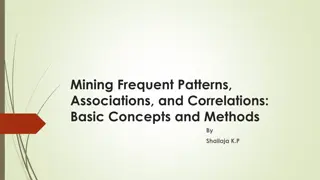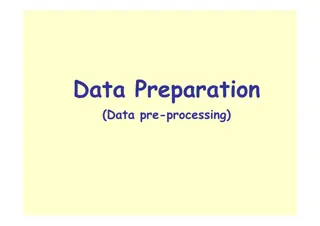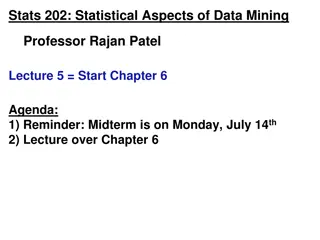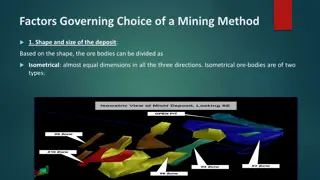Understanding Association Rules in Data Mining
Association rules in data mining involve finding frequent itemsets in baskets of items, leading to insights such as consumer buying patterns, like the classic example of diapers and beer. These rules help identify common sets of items and make predictions about their occurrences in baskets, enabling businesses to optimize sales strategies. By analyzing the contents of baskets and calculating confidence levels, valuable insights can be gained from transactional data.
Download Presentation

Please find below an Image/Link to download the presentation.
The content on the website is provided AS IS for your information and personal use only. It may not be sold, licensed, or shared on other websites without obtaining consent from the author. Download presentation by click this link. If you encounter any issues during the download, it is possible that the publisher has removed the file from their server.
E N D
Presentation Transcript
Jeffrey D. Ullman Stanford University
A large set of items, e.g., things sold in a supermarket. A large set of baskets, each of which is a small set of the items, e.g., the things one customer buys on one day. 2
Simplest question: find sets of items that appear frequently in the baskets. Support for itemset I = the number of baskets containing all items in I. Sometimes given as a percentage of the baskets. Given a supportthresholds, a set of items appearing in at least s baskets is called a frequent itemset. 3
Items={milk, coke, pepsi, beer, juice}. Support = 3 baskets. B1 = {m, c, b} B3 = {m, b} B5 = {m, p, b} B7 = {c, b, j} Frequent itemsets: {m}, {c}, {b}, {j}, B2 = {m, p, j} B4 = {c, j} B6 = {m, c, b, j} B8 = {b, c} , {b,c}, {c,j}. {m,b} 4
Classic application was analyzing what people bought together in a brick-and-mortar store. Apocryphal story of diapers and beer discovery. Used to position potato chips between diapers and beer to enhance sales of potato chips. Many other applications, including plagiarism detection. Items = documents; baskets = sentences. Basket/sentence contains all the items/documents that have that sentence. 5
If-then rules about the contents of baskets. {i1, i2, , ik} j means: if a basket contains all of i1, , ik then it is likely to contain j. Example: {bread, peanut-butter} jelly. Confidence of this association rule is the probability of j given i1, , ik. That is, the fraction of the baskets with i1, , ik that also contain j. Subtle point: probability implies there is a process generating random baskets. Really we re just computing the fraction of baskets, because we re computer scientists, not statisticians. 6
+ B1 = {m, c, b} B3 = {m, b} B5 = {m, p, b} B7 = {c, b, j} B2 = {m, p, j} B4 = {c, j} B6 = {m, c, b, j} B8 = {b, c} _ _ + An association rule: {m, b} c. Confidence = 2/4 = 50%. 7
Typically, data is a file consisting of a list of baskets. The true cost of mining disk-resident data is usually the number of disk I/O s. In practice, we read the data in passes all baskets read in turn. Thus, we measure the cost by the number of passes an algorithm takes. 8
For many frequent-itemset algorithms, main memory is the critical resource. As we read baskets, we need to count something, e.g., occurrences of pairs of items. The number of different things we can count is limited by main memory. Swapping counts in/out is a disaster. 9
The hardest problem often turns out to be finding the frequent pairs. Why? Often frequent pairs are common, frequent triples are rare. Why? Support threshold is usually set high enough that you don t get too many frequent itemsets. We ll concentrate on pairs, then extend to larger sets. 10
Read file once, counting in main memory the occurrences of each pair. From each basket of n items, generate its n(n-1)/2 pairs by two nested loops. Fails if (#items)2 exceeds main memory. Example: Walmart sells 100K items, so probably OK. Example: Web has 100B pages, so definitely not OK. 11
1. Count all pairs, using a triangular matrix. I.e., count {i,j} in row i, column j, provided i < j. But use a ragged array, so the empty triangle is not there. 2. Keep a table of triples [i, j, c] = the count of the pair of items {i, j} is c. (1) requires only 4 bytes/pair. Note: always assume integers are 4 bytes. (2) requires at least 12 bytes/pair, but only for those pairs with count > 0. I.e., (2) beats (1) only when at most 1/3 of all pairs have a nonzero count. 12
1212 per point per occurring pair 4 per pair Triangular matrix Tabular method 13
Number items 1, 2,, n. Requires table of size O(n) to convert item names to consecutive integers. Count {i, j} only if i < j. Keep pairs in the order {1,2}, {1,3}, , {1,n}, {2,3}, {2,4}, , {2,n}, {3,4}, , {3,n}, , {n -1,n}. Find pair {i, j}, where i<j, at the position: (i 1)(n i/2) + j i Total number of pairs n(n 1)/2; total bytes about 2n2. 14
A two-pass approach called a-priori limits the need for main memory. Key idea: monotonicity: if a set of items appears at least s times, so does every subset of the set. Contrapositive for pairs: if item i does not appear in s baskets, then no pair including i can appear in s baskets. 16
Pass 1: Read baskets and count in main memory the occurrences of each item. Requires only memory proportional to #items. Items that appear at least s times are the frequent items. 17
Pass 2: Read baskets again and count in main memory only those pairs both of which were found in Pass 1 to be frequent. Requires memory proportional to square of frequent items only (for counts), plus a table of the frequent items (so you know what must be counted). 18
Frequent items Item counts Counts of pairs of frequent items Pass 1 Pass 2 19
You can use the triangular matrix method with n = number of frequent items. May save space compared with storing triples. Trick: number frequent items 1, 2, and keep a table relating new numbers to original item numbers. 20
For thought: Why would we even mention the infrequent items? Old # s New # s 1. 1 2. - 3. 2 Counts of pairs of frequent items Item counts Pass 1 Pass 2 21
For each size of itemsets k, we construct two sets of k-sets (sets of size k): Ck= candidate k-sets = those that might be frequent sets (support > s) based on information from the pass for itemsets of size k 1. Lk = the set of truly frequent k-sets. 22
All pairs of items from L1 Count the items Count the pairs To be explained All items Filter Filter Construct Construct C1 L1 C2 L2 C3 First pass Second pass Frequent pairs Frequent items 23
C1 = all items In general, Lk = members of Ck with support s. Requires one pass. Ck+1 = (k+1)-sets, each k of which is in Lk. For thought: how would you generate Ck+1 from Lk? Enumerating all sets of size k+1 and testing each seems really dumb. 24
At the kth pass, you need space to count each member of Ck. In realistic cases, because you need fairly high support, the number of candidates of each size drops, once you get beyond pairs. 25
During Pass 1 of A-priori, most memory is idle. Use that memory to keep counts of buckets into which pairs of items are hashed. Just the count, not the pairs themselves. For each basket, enumerate all its pairs, hash them, and increment the resulting bucket count by 1. 27
A bucket is frequent if its count is at least the support threshold. If a bucket is not frequent, no pair that hashes to that bucket could possibly be a frequent pair. On Pass 2, we only count pairs of frequent items that also hash to a frequent bucket. A bitmap tells which buckets are frequent, using only one bit per bucket (i.e., 1/32 of the space used on Pass 1). 28
Frequent items Item counts Bitmap Counts of candidate pairs Hash table for pairs Pass 1 Pass 2 29
Space to count each item. One (typically) 4-byte integer per item. Use the rest of the space for as many integers, representing buckets, as we can. 30
FOR (each basket) { FOR (each item in the basket) add 1 to item s count; FOR (each pair of items) { hash the pair to a bucket; add 1 to the count for that bucket } } 31
1. A bucket that a frequent pair hashes to is surely frequent. We cannot eliminate any member of this bucket. 2. Even without any frequent pair, a bucket can be frequent. Again, nothing in the bucket can be eliminated. 3. But if the count for a bucket is less than the support s, all pairs that hash to this bucket can be eliminated, even if the pair consists of two frequent items. 32
Replace the buckets by a bit-vector (the bitmap ): 1 means the bucket is frequent; 0 means it is not. Also, decide which items are frequent and list them for the second pass. 33
Count all pairs {i, j} that meet the conditions for being a candidate pair: 1. Both i and j are frequent items. 2. The pair {i, j}, hashes to a bucket number whose bit in the bit vector is 1. 34
Buckets require a few bytes each. Note: we don t have to count past s. If s < 216, 2 bytes/bucket will do. # buckets is O(main-memory size). On second pass, a table of (item, item, count) triples is essential. Thus, hash table on Pass 1 must eliminate 2/3 of the candidate pairs for PCY to beat a-priori. 35
The MMDS book covers several other extensions beyond the PCY idea: Multistage and Multihash. For reading on your own, Sect. 6.4 of MMDS. Recommended video (starting about 10:10): https://www.youtube.com/watch?v=AGAkNiQnbjY 36
Take a random sample of the market baskets. Do not sneer; random sample is often a cure for the problem of having too large a dataset. Run a-priori or one of its improvements (for sets of all sizes, not just pairs) in main memory, so you don t pay for disk I/O each time you increase the size of itemsets. Use as your support threshold a suitable, scaled-back number. Example: if your sample is 1/100 of the baskets, use s/100 as your support threshold instead of s. 38
Optionally, verify that your guesses are truly frequent in the entire data set by a second pass. But you don t catch sets frequent in the whole but not in the sample. Smaller threshold, e.g., s/125 instead of s/100, helps catch more truly frequent itemsets. But requires more space. 39
Partition the baskets into small subsets. Read each subset into main memory and perform the first pass of the simple algorithm on each subset. Parallel processing of the subsets a good option. An itemset is a candidate if it is frequent (with support threshold suitably scaled down) in at least one subset. 40
On a second pass, count all the candidate itemsets and determine which are frequent in the entire set. Key monotonicity idea: an itemset cannot be frequent in the entire set of baskets unless it is frequent in at least one subset. 41
Start as in the simple algorithm, but lower the threshold slightly for the sample. Example: if the sample is 1% of the baskets, use s/125 as the support threshold rather than s/100. Goal is to avoid missing any itemset that is frequent in the full set of baskets. 42
Add to the itemsets that are frequent in the sample the negative border of these itemsets. An itemset is in the negative border if it is not deemed frequent in the sample, but all its immediate subsets are. Immediate subset= delete exactly one element. 43
{A,B,C,D} is in the negative border if and only if: 1. It is not frequent in the sample, but 2. All of {A,B,C}, {B,C,D}, {A,C,D}, and {A,B,D} are. {A} is in the negative border if and only if it is not frequent in the sample. Because the empty set is always frequent. Unless there are fewer baskets than the support threshold (silly case). Useful trick: When processing the sample by A-Priori, each member of Ck is either in Lk or in the negative border, never both. 44
Negative Border tripletons doubletons Frequent Itemsets from Sample singletons 45
In a second pass, count all candidate frequent itemsets from the first pass, and also count sets in their negative border. If no itemset from the negative border turns out to be frequent, then the candidates found to be frequent in the whole data are exactly the frequent itemsets. 46
What if we find that something in the negative border is actually frequent? We must start over again with another sample! Try to choose the support threshold so the probability of failure is low, while the number of itemsets checked on the second pass fits in main-memory. 47
We broke through the negative border. How far does the problem go? Negative Border tripletons doubletons singletons Frequent Itemsets from Sample 48
If there is an itemset that is frequent in the whole, but not frequent in the sample, then there is a member of the negative border for the sample that is frequent in the whole. 49
Suppose not; i.e.; 1. There is an itemset S frequent in the whole but not frequent in the sample, and 2. Nothing in the negative border is frequent in the whole. Let T be a smallest subset of S that is not frequent in the sample. T is frequent in the whole (S is frequent + monotonicity). T is in the negative border (else not smallest ). 50























